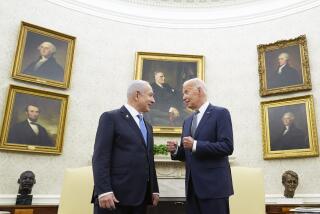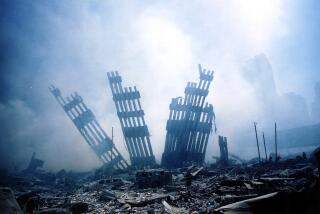U.S. Seeks Public’s Help in Search for 5 From Al Qaeda
WASHINGTON — U.S. authorities warned the public Thursday to be on the lookout for five Al Qaeda operatives who taped messages of martyrdom and may have been planning terrorist acts against the United States.
U.S. soldiers recently found videotapes of the men’s suicide messages in the rubble of a top Osama bin Laden lieutenant’s home in Afghanistan, suggesting a closer link than previously thought between Bin Laden and his foot soldiers.
One of the five suspected terrorists--Ramzi Binalshibh of Yemen--tried unsuccessfully to enter the United States at least three times and is wanted by Germany as an accomplice of the Sept. 11 hijackers. Authorities have been unable to find him or the other four men in the declassified videotapes that were released in abridged form Thursday.
Although authorities are uncertain when the five videotapes were made or how Al Qaeda intended to use them, they “appear to be sort of martyrdom messages from suicide terrorists. And whether or not the attack would be imminent or not is something we can’t determine,” Atty. Gen. John Ashcroft said.
“These men could be anywhere in the world,” Ashcroft said. “We’re not able to say that they’re in one location or another, or whether they’re dead or alive.”
Even so, authorities said the public should be on guard. The FBI is hoping that release of the men’s photographs and three of the videotapes may produce tips leading to the suspects’ capture. The sound was edited out of the tapes, pending further translation work.
In one videotape, an alleged Al Qaeda operative identified by the FBI as Khalid Ibn Muhammad Al-Juhani is seen laughing and pressing his lips to the end of a military-style rifle. Other men were identified as Binalshibh, Abd Al-Rahim and Muhammad Said Ali Hasan. The fifth man in the tapes has not been identified.
German authorities have issued an arrest warrant for Binalshibh and two alleged accomplices. U.S. authorities say Binalshibh was supposed to be a hijacker in the Sept. 11 attacks but had been denied entry to the United States.
Ashcroft, FBI Director Robert Mueller and other officials have characterized Binalshibh as being linked closely with alleged lead hijacker Mohamed Atta--his former roommate in Hamburg, Germany--and other hijackers. They also say Binalshibh wired money to some of the hijackers when they were living in Florida and training for the attacks.
When Zacarias Moussaoui, a 33-year-old Frenchman of Moroccan descent, was indicted last month on charges of conspiring to kill and maim Americans in the Sept. 11 plot, Binalshibh was named as a co-conspirator. Justice Department officials say he could soon be indicted as well.
The Moussaoui indictment describes how Binalshibh tried to enter the United States repeatedly in an effort to obtain flight training and participate in the Sept. 11 attacks. When he failed, authorities allege, Moussaoui may have intended to take his place. They say Binalshibh wired $14,000 to Moussaoui last summer while he was attending flight school in Norman, Okla.
Moussaoui was arrested in August in Minnesota on immigration charges.
Mueller called the tapes of Binalshibh and the four other men “part of a trove of valuable information being recovered in Afghanistan.”
In the weeks since the Taliban was driven from power, U.S. troops and intelligence operatives have found many pieces of evidence left behind in caves, abandoned houses and bunkers throughout Afghanistan.
A Bush administration official characterized the five videotapes as a key advance in the U.S. government’s knowledge of Al Qaeda and its role in the Sept. 11 plot.
The fact that the tapes were found in the home of Mohammed Atef, a key Bin Laden aide, “could mean that the chain of command between the actual operatives [in the Sept. 11 attacks] and the leadership is shorter than we thought, or that they move material up and down the chain a lot more than we thought,” said the administration official, who spoke on condition of anonymity.
U.S. officials say Atef was killed in a November airstrike around Kabul, Afghanistan’s capital.
FBI investigators are doing forensic tests and detailed translation work on the videotapes in an effort to glean more insight into the men and what they may have been planning. At the same time, the FBI, CIA, Pentagon and other agencies are devoting more resources to the search for evidence in Afghanistan.
“There is an intelligence gold mine that awaits us in Afghanistan,” the administration official said. “We may stumble across critically important material that will help thwart future attacks or help us put together the pieces of the puzzle of how Al Qaeda operates that we did not have before.”
Daniel Benjamin, a counterterrorism expert and former National Security Council aide in the Clinton administration, said authorities need to pursue the chain of command between the five suspected terrorists and Atef, Bin Laden’s top military commander.
“We know that [Atef] was very hands-on,” Benjamin said. “He has been a key link with operatives throughout the Al Qaeda organization. What we don’t know is how these tapes were being distributed, whether they were being used for recruitment or some other informational purpose.”
After a brief lull in the Justice Department’s terrorism investigation, the release of the videotapes comes during a frenetic week that has seen the filing of criminal charges against American Talib John Walker Lindh and alleged “shoe bomber” Richard C. Reid.
Meanwhile, in London, two Algerian men allegedly involved in a plot to bomb the U.S. Embassy in Paris were charged Thursday with being members of Bin Laden’s Al Qaeda terror network. Police said eight others were arrested under Britain’s Terrorism Act in raids north of London.
Both of the Algerian men had been detained by immigration authorities since their arrest Sept. 25 in Leicester, 100 miles north of London, according to the Crown Prosecution Service.
The arrests of the other eight men in Leicester were made “in connection with an ongoing Pan-European anti-terrorist investigation,” according to an official who asked not to be identified. British officers were searching the raided premises Thursday, along with several other addresses in Leicester and London, police said.
“We do believe that progress is being made” in grounding Al Qaeda, Ashcroft said. “But we have a long way to go. This is no time for us to take our foot off the accelerator.”
However, one legal expert questioned whether Ashcroft’s release of the tapes and his urging of Americans to participate in identifying potential hijackers could fuel harassment of Arab Americans and false identifications by amateur sleuths.
“One has to wonder how many men are going to be picked up or identified from these pictures,” said Jonathan Turley, a George Washington University law professor. “The problem with saying these men could be anywhere means that they will inevitably be found everywhere. There is always the danger that release of these [tapes] could trigger a ‘most wanted’ frenzy by G-men wannabes.”
More to Read
Sign up for Essential California
The most important California stories and recommendations in your inbox every morning.
You may occasionally receive promotional content from the Los Angeles Times.









